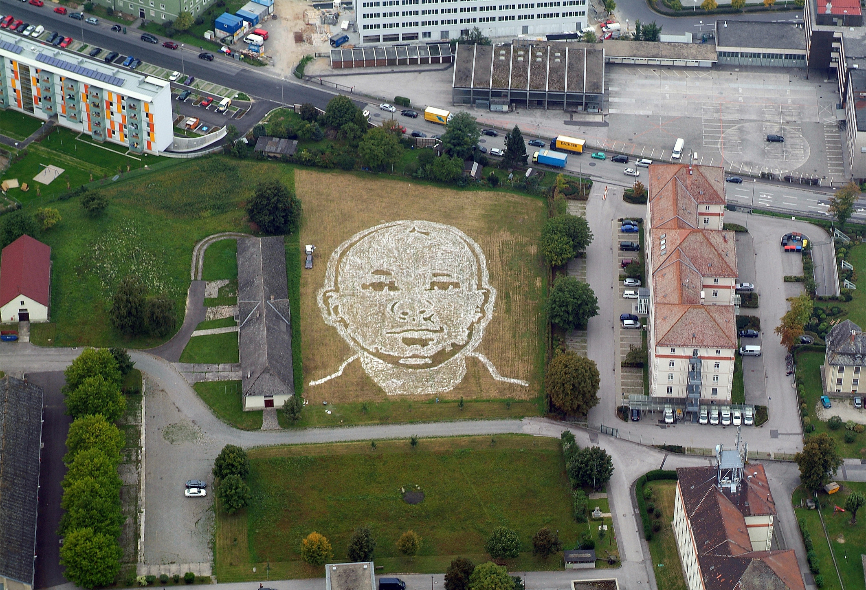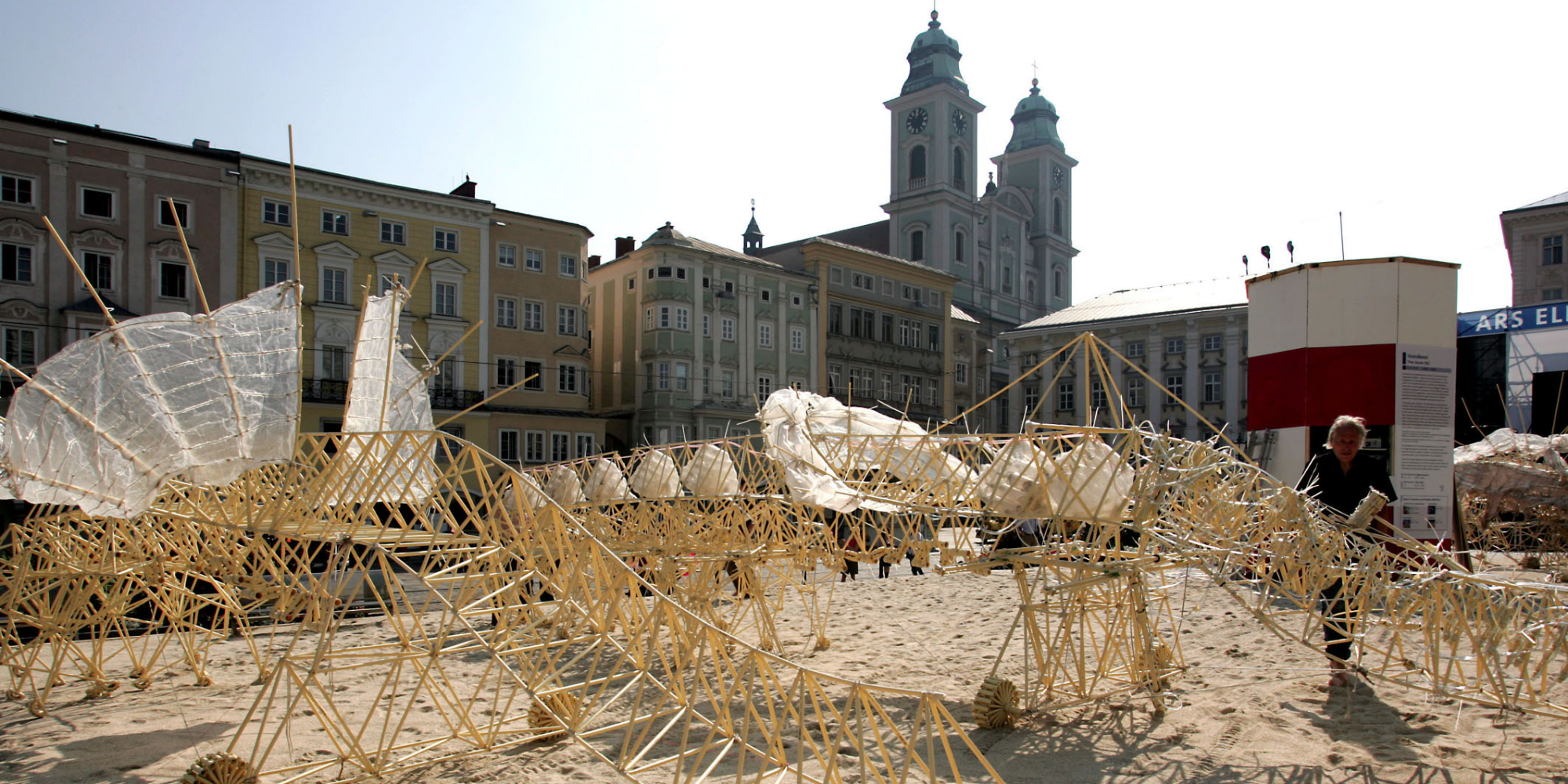The LENTOS Art Museum, located on the southern bank of the Danube opposite the Ars Electronica Center, has the largest museum space in Austria and hosts every year the Featured Artist Exhibition of Ars Electronica. This year, for the first time, the focus is not on an artist or an artist collective, but on Ars Electronica itself. “Ars and the City” celebrates the 40th anniversary of our institution, but also and above all focuses on our relationship with the city of Linz. Companions will tell stories, projects from past years will be on display, and last but not least, it’s all about how the two, Ars Electronica and the City of Linz, have influenced each other. Festival director Martin Honzik and project manager Viktoria Wöss invite the audience to join them on a journey through time during the Ars Electronica Festival 2019: Out of the Box.
In LENTOS the Featured Artist Exhibition is shown every year at the Ars Electronica Festival. Who or what awaits us this year in this art museum on the opposite side of the Danube?
Martin Honzik: “Featured Artist” in LENTOS this year is a retrospective on the history of Ars Electronica and the conquest of public space in the city of Linz. Ars Electronica has always been formative in its cooperation with the independent scene, the Freie Szene, and with other artist collectives in the public space of the city of Linz – where it has left a lasting, formative influence on what art, digital art, and media art are capable of doing outside the white cube situation. Humanizing Technology is, so to speak, the meta-level where artistic projects have publicly demonstrated that technology per se can be a connecting element, as long as one does not forget on a philosophical level that the human being remains in the center. The first Ars Electronica event, the Klangwolke 1979, was actually already a prototype of how art can be used to create a unifying context. In this case, the classical music world was connected to the public through the use of radio in the windows.
“The Ars Electronica has always been formative in its cooperation with the independent scene and with other artist collectives in the public space of the city of Linz (…)”.
There are two epicenters where we refer to the history of Ars Electronica. One is in LENTOS – the physical public space – Ars and the City. Another is in the former Himatsubushi Trail – Ars on the Wire – the definition of the new public space that is generated via the Internet, via digital, globally networked media, and that is still a focus of society as a whole. Ars Electronica has always identified it as a public space that must be subject to the same laws as the real public space. One only needs to look at where we are today, what culture of communication prevails in virtual spaces, because apparently there are no regulations applied et ceterea, et ceterea. In LENTOS it will be a lot about these collaborations that we made in the past, the independent scene will be strongly represented, meanwhile there is a clear clustering in four sub-themes.

Viktoria Wöss: We have now reviewed all the material available, including the 30-year book. The main isles, that will be created, are the Voest, the Stadtwerkstatt, the Donaupark and the Hauptplatz.
Martin Honzik: The Voest because the Voest was not yet a high-tech plant at a certain time, and the Voest housed Contained, which later became Time’s Up. Because the Voest was of course rich in cool, interesting locations. There are legendary projects that brought us into the context of Voestalpine or directly took place there: For example, the train staged by Fadi Dorninger, “Ridin’a train” is one of the most legendary projects of Ars Electronica.

So the whole thing is a retrospective on the history of Ars Electronica?
Martin Honzik: These two things, On the Wire and And the City, are the only two exhibition formats we’ve programmed and curated that really deal exclusively with the history of Ars Electronica. That’s not a linear countdown, of course we’re also playing with quantity, with the evaluation of all the projects that have taken place in public space to show where we’ve done our work, where Ars Electronica has made an impact – and that’s an infinite number. Of course, you have to extract qualitative projects from this quantity. That’s what we use as an opportunity, protagonists from the past, leading staff, various festival directors, various producers, cooperation partners, Time’s Up, Stadtwerkstatt – I repeat myself – there will be interviews. They will each be asked a question about what Ars Electronica is for them, and these interviews will enrich the place. The location itself will be a mixture of a chronological, historical, detail-loving project collection. But it will then three-dimensionally highlight some projects that, from our subjective point of view, had a relevance for our history and in some way contributed homoeopathically to changing the atmosphere in this city.

Which projects, for example, will be on display?
Viktoria Wöss: In the beginning there was the legendary Klangwolke 1979, where they put the radios in the windows. In the beginning, Ars Electronica was held every two years, always together with the Klangwolke. The universe of Isao Tomita in 1984 is important, the Große Klangwolke, also the Linzer Stahloper in 1982, the Linzer Stahlsinfonie in 1980, … – here, too, the connections to Voest over and over again. The Klangpark was important – Ars Electronica was still in the Brucknerhaus at the time, but people were already going out into the Donaupark and installing things there. Back then, as well, they performed in many places in the city; it wasn’t always only concentrated in one place.
Martin Honzik: It will also be about works that happened in cooperation with the Stadtwerkstatt, those were always things that were commissioned. There was a lot of money at that time to invent projects. Checkpoint 95, for example, was a story where the whole bridge was blocked, where in a time of the Cold War the Danube was seen as the separating border symbol it had always been. It was closed and via telecommunications two veterans of the world wars communicated with each other beyond political borders. With a bridge barrier and, and, and this was a very opulent event.

Viktoria Wöss: And what happened on television was also really great. The pictures were then interlaced with each other and it completely dissolved.
Martin Honzik: The whole thing, one has to add, makes no claim to completeness. Given the flood of projects and information, a selection had to be made. As already mentioned at the beginning, the people who have shaped the Ars Electronica format will also be at the center of attention. Those who pushed this mission of going into public space and influenced it creatively with their help. Contemporary witnesses, hybrids who produce, but also curate, and have shaped many things.

Martin Honzik is an artist and director of Ars Electronica’s Festival, Prix and Exhibitions divisions. He studied visual experimental design at Linz Art University (graduated in 2001) and completed the master’s program in culture & media management at the University of Linz and ICCM Salzburg (graduated in 2003). Besides being independent Artist in several art projects, he joined the staff of the Ars Electronica Futurelab, where, until 2005, his responsibilities included exhibition design, art in architecture, interface design, event design and project management. Since 2006, Martin Honzik has been director of the Ars Electronica Festival and the Prix Ars Electronica and in charge of the exhibitions in the Ars Electronica Center as well as Ars Electronica’s international exhibition projects.
For a complete overview of 40 years of Ars Electronica, visit the Ars Electronica Festival from September 5 to 9, 2019. The exhibition “Ars and the City” is located in LENTOS, the exhibition “Ars on the Wire” in the upper floors of POSTCITY. To learn more about the festival, follow us on Facebook, Twitter, Instagram et al., subscribe to our newsletter and visit our website at https://ars.electronica.art/outofthebox/en/.
